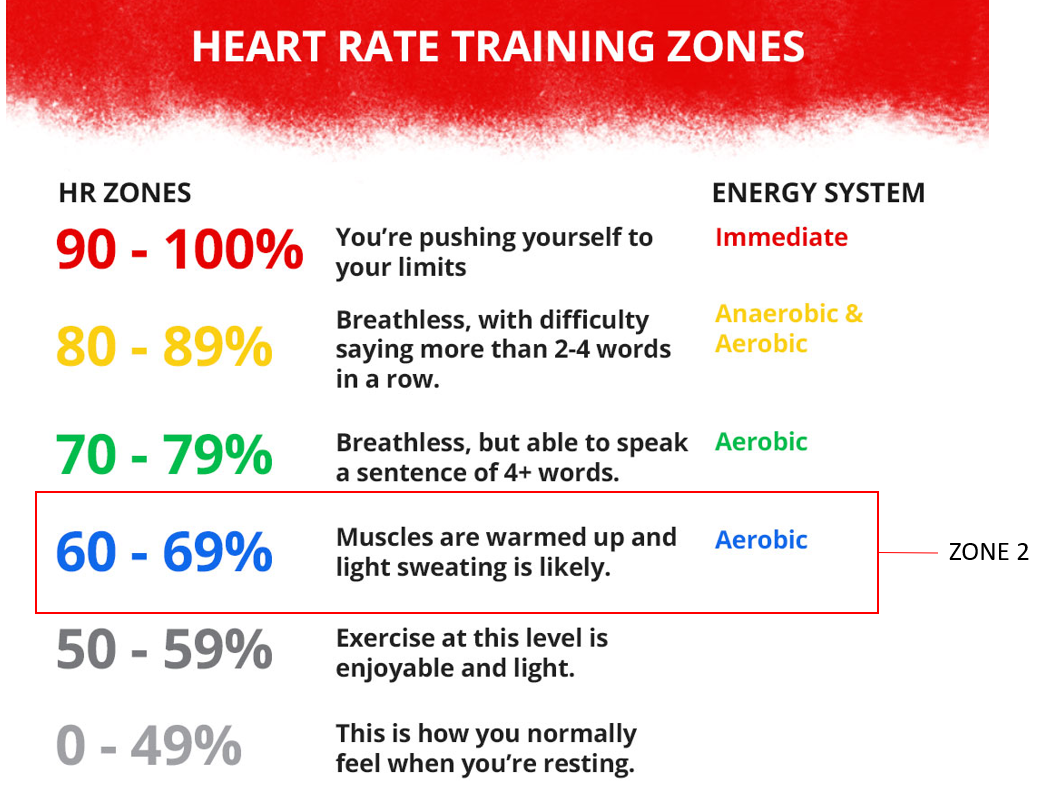We are conditioned that workouts should be a grind… Sentiments like, “you should burn more than 400 calories or it’s not even worth it”; or, “that full hour at the gym should leave you sweaty and spent”; and the worst, “push through the pain!”
Stop the insanity!
High intensity training has its place but should not be the default. Overexercise and overexertion are harmful to the body and can, in fact, have adverse effects on health, weight loss and muscle gain.
The magic is in Zone 2 training.
Zone 2 training allows the body to recover and access fat stores.
What is Zone 2 Training?
Zone 2 training is typically the lowest zone used for training purposes. Think of it as going for a jog while you can still hold a conversation, or taking a brisk walk. You will be somewhere between 60 – 70% of your maximum heart rate. The purpose behind Zone 2 training is to be able to sustain a pace just below your aerobic threshold for 30+ minutes.
Understanding Heart Rate Zones
There are three energy systems that produce the chemical energy our bodies then use during movement.
The first system provides immediate energy due to the breakdown of a small amount of stored energy in our cells. This system is anaerobic, meaning it occurs in the absence of oxygen. It produces enough energy to sustain high-intensity exercise for about 10 – 30 seconds.
The next system is Anaerobic Glycolysis, which breaks down carbohydrates into energy but still in the absence of oxygen. In this process, glucose in the bloodstream is broken down into energy, water and lactate. Anaerobic glycolysis can usually sustain us for moderate- to high-intensity activities of about 30 seconds to 3 minutes.
The last system is Aerobic Metabolism. This is Zone 2 and where the magic happens. This is because Zone 2 requires oxygen to work and it breaks down glucose (sugars) and Beta Oxidation (fatty acids) to produce energy. It is the primary energy system used for low- to moderate-intensity activities lasting longer than about 3 minutes. This is where the body uses stored fat and sugar and turns it into energy, thereby causing weight loss and improved muscle tone.
Training hard at 100 – 70% every time only trains that one high-intensity system in the body. You cannot lose fat or build muscle at this level. For example, running super hard and fast will pull the energy from muscles instead of fat. Whereas walking at a brisk pace for 30 – 45 minutes gives the body time to convert fat into energy.

Perimenopausal Women and Zone 2 Training
Women should not be training hard every day because it keeps the body in this hyper-intense state that does not allow your body the time to convert fat into energy. Zone 2 training is especially beneficial for women who are 40 – 50 years old and perimenopausal. Perimenopausal is defined by women who are still cycling but irregularly.
When a woman enters perimenopause, she may start to experience weight gain without significant change in diet, sleeping issues, increased abdominal fat, and difficulty losing weight. Usually, her cycle is all over the map – some periods may be heavy, or she may skip two to three cycles and then bleed every 15 days. It is your body’s last stitch effort to be fertile and it can wreak havoc on your weight, hormones and mood.
If you are training at a high intensity all the time, then your body is burning more immediate energy and will crave high carb, high sugar foods to replenish and respond. By training at Zone 2, your body can use oxygen and access fat stores to burn. If you never allow your body to get to a homeostatic state, then you will have a hard time losing weight.
For women who are perimenopausal and always trying to hit that high, you run the risk of messing up your hormones. By stressing out that cortisol and adrenal system, you force your body to produce more cortisol. An excess of cortisol in the bloodstream inhibits production of insulin making it hard to lose weight. When cortisol is going all the time, then we do not have enough raw materials to make any of our estrogen or progesterone and it puts everything off balance.
Find Your Balance with Zone 2 Training
First step: get rid of that mindset that you need an hour to work out every time. Thirty minutes of Zone 2 training allows the body to recover and access fat stores. That said, you may not make your goals if all you do is go for walks. You need to have a balance that mixes it up and includes plenty of Zone 2 training. For example, you may find that brisk walking (Zone 2) and two-time a week HIIT training is what your body needs. Or that a moderate yoga class (Zone 2) and weights training is where you hit your stride for weight loss and energy.
The whole idea behind well-rounded training that includes Zone 2 is to have cardio, balance, and strength all combined. If you only train one system, or at one intensity, then you won’t have a well-balanced body. If you want more information on fat burning and maximizing aerobic function in Zone 2, we highly recommend this podcast with Dr. Stephanie Estima and Dr. Phil Maffetone. And if you are perimenopausal and want to learn more about Zone 2 and hormones and how they affect weight loss, schedule a consultation for functional medicine health coaching.





